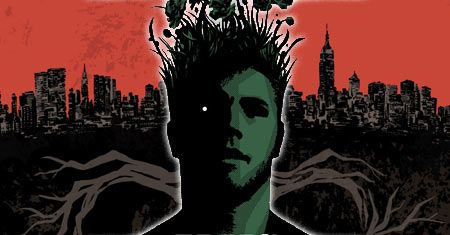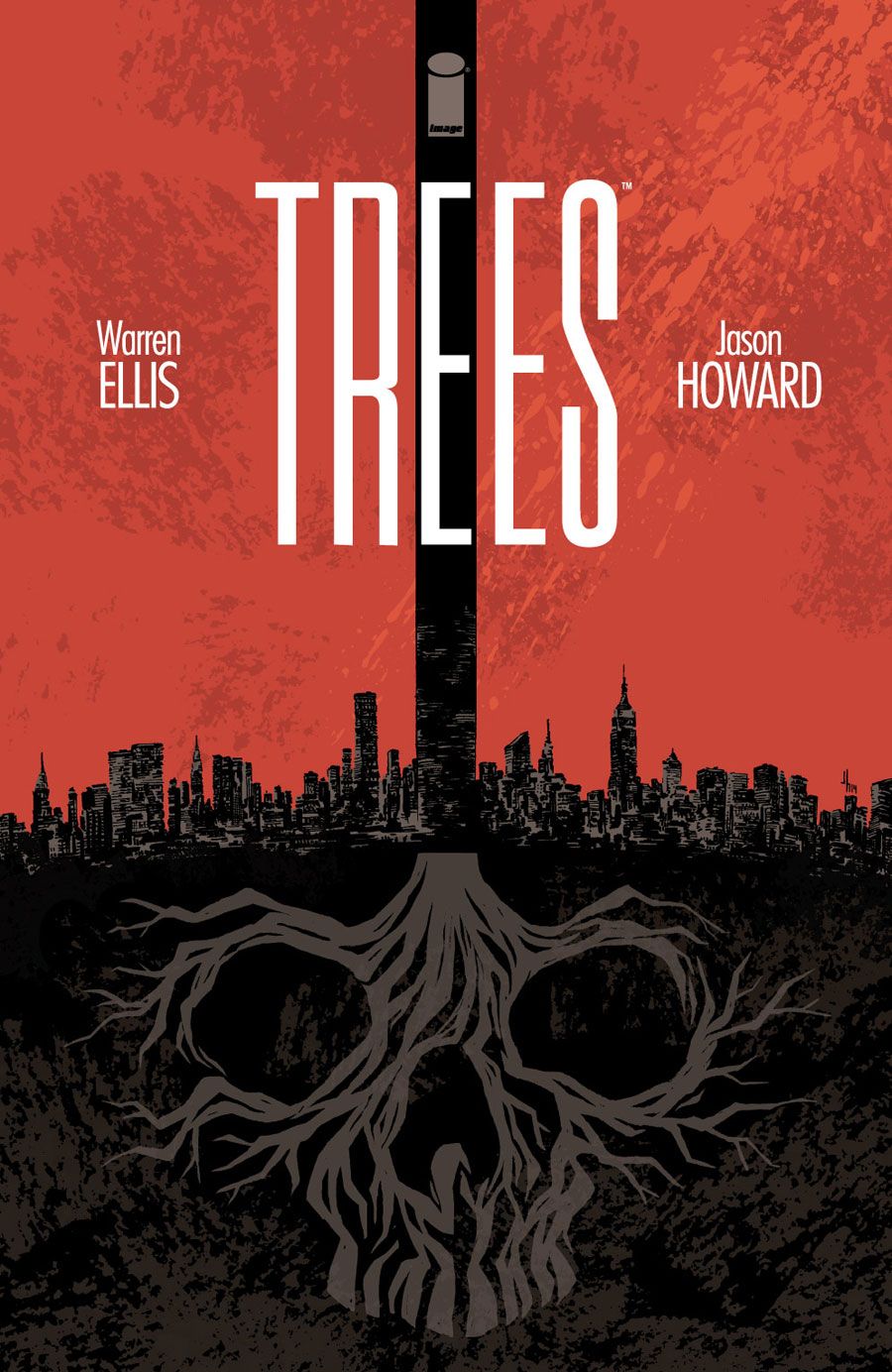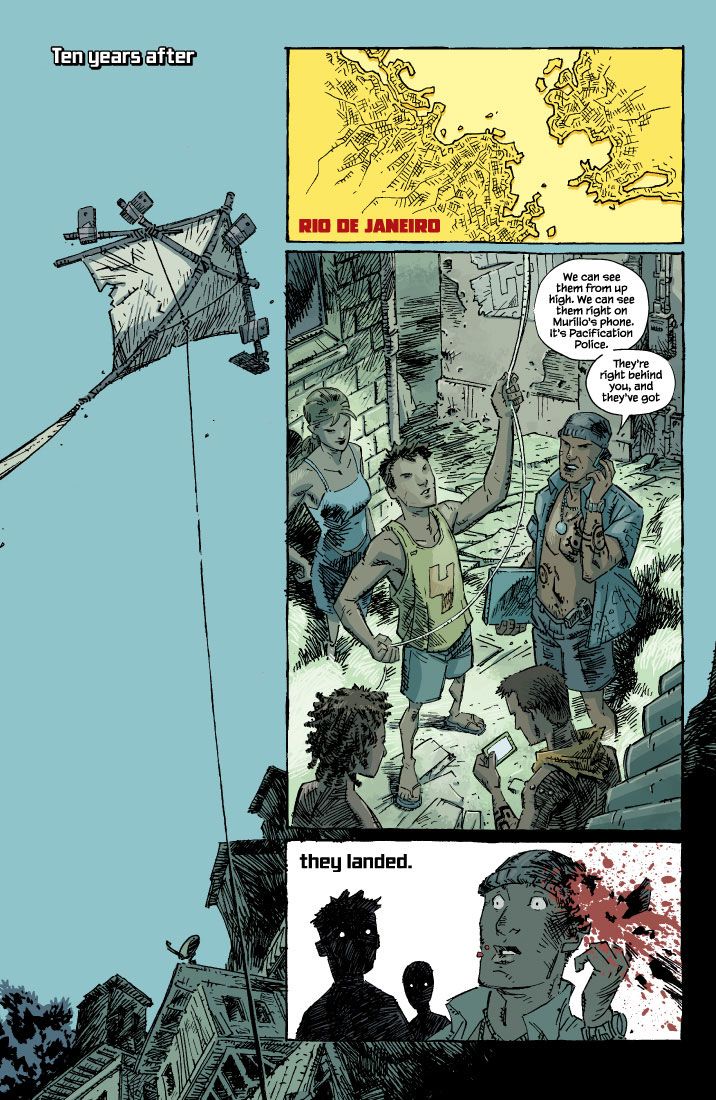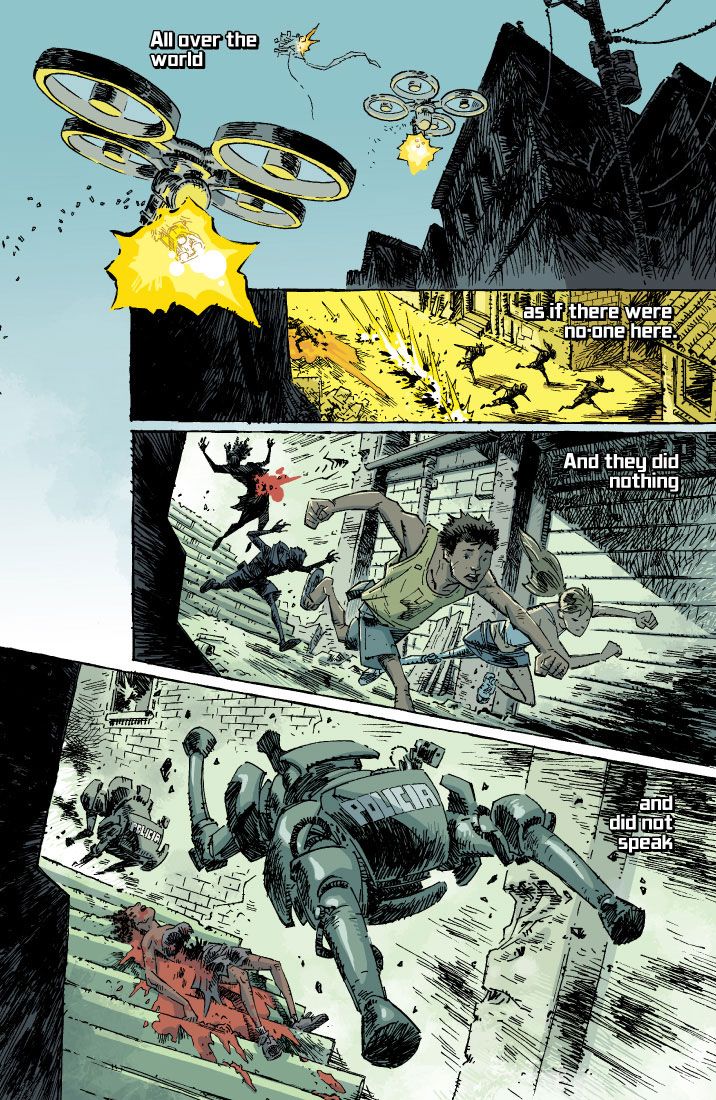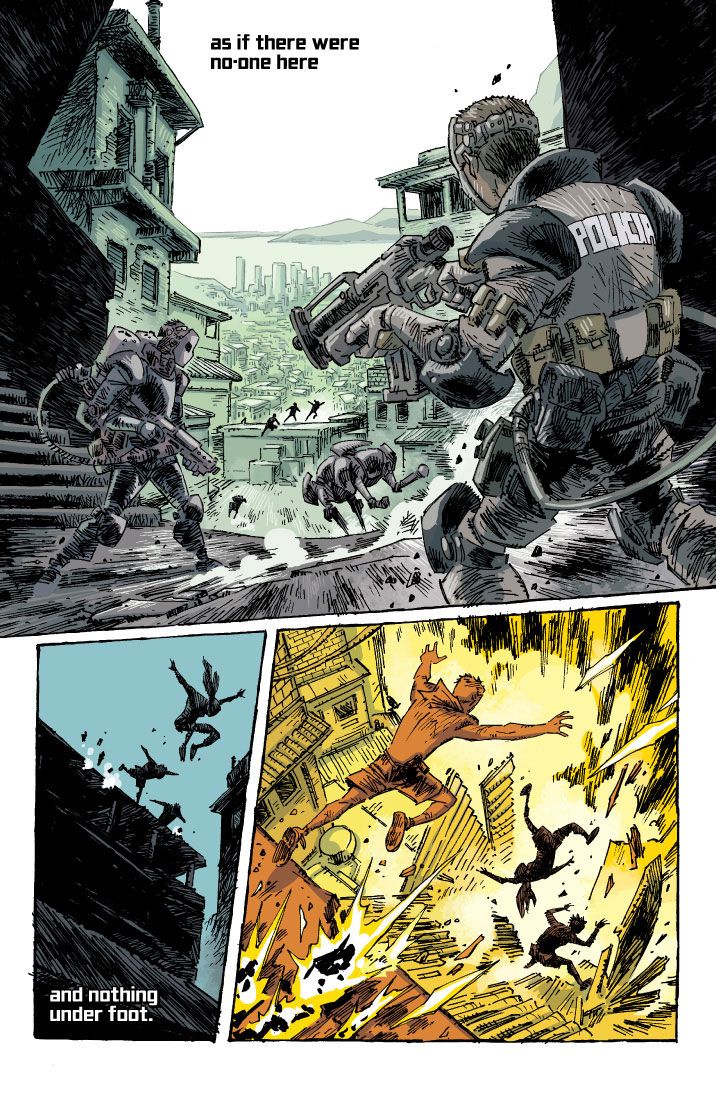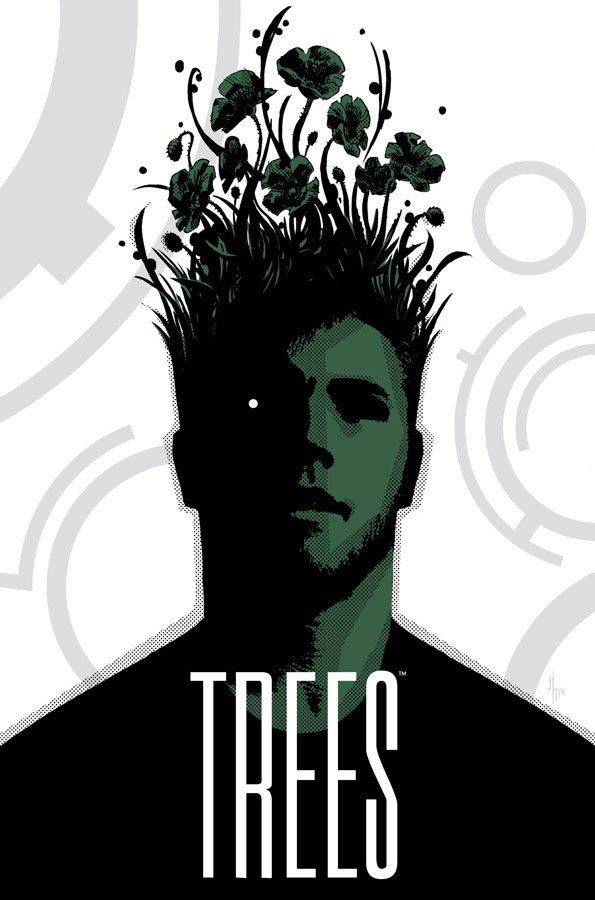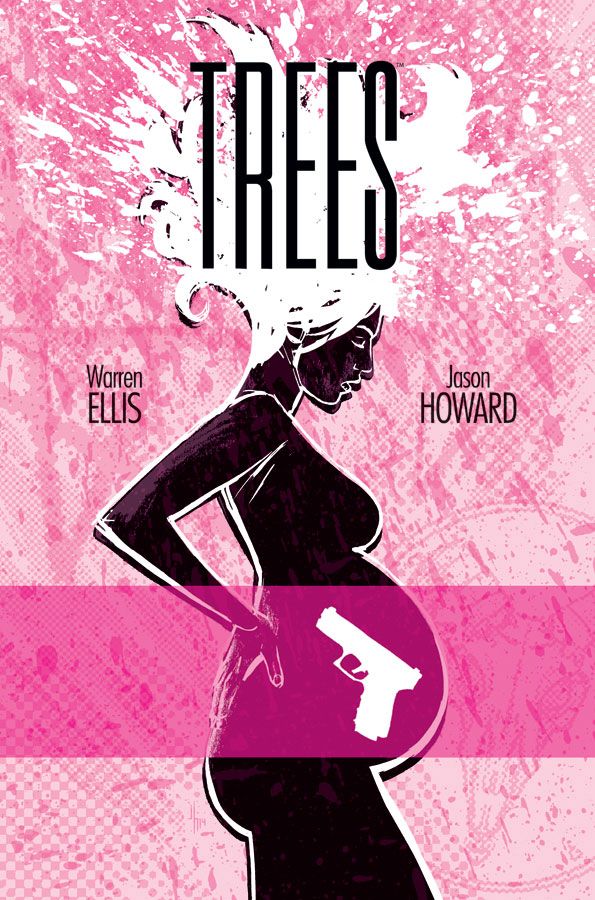So many alien invasion stories follow a basic premise -- hostile beings from another world invade ours by force, attempting to take control through violence and massive explosions. But what if the invasion was silent? What if the visitors didn't seem to want anything? What if they were just... there? That's the question asked in "Trees," a new sci-fi miniseries by Warren Ellis and artist Jason Howard, coming to Image Comics in May.
"Trees" takes place a decade after silent, sentient creatures resembling enormous trees invade the Earth. These creatures don't seem to want anything from us, nor do they even acknowledge mankind's existence, simply putting down roots and keeping an unsettling vigil over the planet. While an understandable amount of chaos followed their arrival, things have calmed down and society has accepted their presence, but little is known about these mysterious invaders. Told through four distinct storylines, "Trees" explores the aftermath of the invasion.
RELATED: Warren Ellis Confirms New Image Series, "Trees"
Artist Jason Howard joined CBR News to give us more details on the series, which has somehow maintained an astonishingly subtle presence since its announcement, and what it's like working with Warren Ellis.
CBR News: You and Warren previously worked together on "Scatterlands" -- how did "Trees" come about?
Jason Howard: "Scatterlands" was designed from the beginning to be a web serial, something that would be an experiment for both of us. Warren had ideas about what he wanted to do with story and structure and I wanted a chance to experiment with my art in ways that wouldn't fit the visual look I had established for "Super Dinosaur." It was basically something fun I could do at the end of my normal workday. The first chapter ran for 50 days and has been collected and is digitally available DRM free from Image.
Anyway,Warren and I had a blast working on it and when I had a break coming up in my schedule we decided to develop something new to fill it. Warren referred to it as doing a "proper comic." That "proper comic" became "Trees."
The artwork is really stunning. How do you develop the look of the series -- what does the development of the aesthetic look like?
Thank you! The development is a lot of sketchbook pages. [Laughs]. I mentioned "Super Dinosaur" and I love that book, but one of the things I've realized that that when you have long runs on a book it can be difficult to experiment too much with style. I didn't want issue #20 of "Super Dinosaur" to suddenly look like it had been drawn by someone different, I want it to be consistent and while hopefully the art is improving, it should be generally on model to the look I established at the beginning of the series. So while drawing "Super Dinosaur" I would be experimenting and trying new things out in my sketchbook and ultimately pushed it further with "Scatterlands."
The approach I'm taking now with "Trees" comes out of all that. It's a looser, more line-y approach with inks than the clean, simpler approach I took with "Super Dinosaur" or even "The Astounding Wolf-Man." The development process was both fun and frustrating, I think I inked almost half of the first issue two times just to get in a place where I was comfortable with the results. But I love that part of the process, where you're sort of searching for the visual look of the book. I had the first 2 issues' scripts pretty early on, and that really helped give me a sense of the story and I did my best to take what I was doing and tailor it to fit the tone and feel of what Warren was writing.
RELATED: Kirkman & Howard Have a "Super Dinosaur"
You do some really interesting stuff with panel placement and pacing. Is that something Warren gives you free reign over?
Warren's scripts for "Trees" are clear but not overly art directed. He will sometimes give direction on if he thinks something should be a small panel or wide panel, but for the most part the panel placement is up to me. I do send Warren layouts for him to look over before I do finished art, so if something isn't working he can comment on it. But it's a pretty smooth process.

I'm so curious to find out how this story was pitched to you-- "it's trees, except they're aliens. And they sort of kill people." What was your reaction when you started learning about the concept?
When we were developing the idea Warren asked me what kind of things I wanted to draw. I sent him a folder of a bunch of images that inspired me. From there he sent me the basic idea of, what if aliens landed and didn't seem to do anything? What happens to society when these alien structures land but nothing comes out and after a while they become normal and they just stand there, like trees? I thought that sounded fascinating and could immediately visualize situations and story potential. I excitedly told him I loved it and we were off.
It's such an interesting concept, that something that looks like a tree, which we consider to be passive, pleasant things, can be so menacing. When you were conceiving the look of the trees, what qualities were important to you to bring out? Just from the first cover alone, it's clear that evil lurks beneath their branches...
I did a lot of development on the look of the Trees themselves. While I explored a several directions I ultimately felt like something simple and monolithic seemed to work the best. In my mind was the idea that a Tree could visually fit in any culture because it didn't have a culture of its own. That sounds kinda silly now that I write it, but in my head it makes sense. I also wanted them to feel big. Just really huge things that could in no way have been built by humans. Creating environment and a sense of scale is something that I am working hard to bring out in this book.
Do the trees have an agenda? I don't want to get spoilery, but the story seems really based around people's reactions to these things. Their initial landing was clearly rough, but are the Trees doing anything to continue fear of them?
Warren really is writing a very human story within this changed world of "Trees." The characters and their situations and strange little corners of the world really get explored and I think people are going to dig what we're doing here. As far as to what the Trees themselves may or may not be doing, I don't really want to get to much into this as it touches on story points, but the first issue cover strongly hints that they may not be happy trees...

In this first issue, we see four separate narratives: ten years ago when the trees first landed, present day New York, present day Shu and an Arctic Spiztbergen. Are all four of these narratives going to continue through the story?
Yes, these narratives will continue and as the series continues other parts of the world will be explored as well. For me, part of the fun drawing the book is having these varied setting to play in. I enjoy drawing variety and with the story taking place all over the globe I get draw locations as varied as the Favela's in Brazil to the arctic.
In these four arcs we see immediate reactions to the existence of the Trees -- anger, curiosity, fear and research. What other types of reactions are people having to them? Are there others who embrace, like, say, Tree worshipers?
Warren and I discussed a lot of the different situations that could come up and how people might react to the arrival of the Trees. From the possibility of religious cults to extreme sports to other darker things.
I love how there are style/color differentiations with each story that really sets them apart from one another. Can you talk about your approach to that?
I really try to use color to create a sense of mood and of place, so in the book as the story changes locations the color palette will change to help create a sense of the environment change. I think one of the most fun parts of coloring comics is really pushing the color and seeing what kind of unusual color combinations you can make work.
I noticed a design that is used several times in the book; a sort of biological circular pattern. Is this a nod to crop circles?
A little, yeah. It's a symbol that we see in different places as the story continues and sort of hints at things about the Trees themselves.
What is the current climate like in each of the modern day storylines? It's been ten years since the trees first landed -- where are people at emotionally? Have the trees just become a thing they live with?
This question is really the heart of the series. Would these things just become normal? How would different societies react to them? Warren is exploring these ideas in ways that I think are really interesting. Through the story we will follow characters that relate to the Trees in very different ways and have very different ideas of what they mean.
"Trees" #1 puts down roots May 28.

